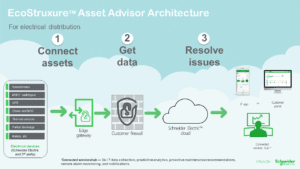Unplanned downtime due to aging, damaged, and unmaintained electrical equipment can cost your business valuable time and money. For industrial plants, a one-hour shutdown may cost up to $250,000. Fortunately, many problems that arise at your facility are simple to spot and resolve: a tripped breaker or a blown fuse, for example.
But other issues — particularly those that happen out of sight, aren’t as easy to identify. And these may present significant financial, productivity, and safety impacts.
One hard-to-detect problem particularly common in facilities with aging electrical equipment is partial discharge, an internal arcing that happens in medium voltage switchgear. When partial discharge goes undetected over time — and it often does — it can damage equipment and injure personnel.
Working with a real-time monitoring service is one way facility managers can track switchgear health and make plans for future preventive maintenance if an issue such as partial discharge is detected.
In this post, I break down the specifics on partial discharge, discuss the potential impacts it can have on your facility, and offer a monitoring solution designed to prevent a loss from equipment failure.
Small sparks that signal big problems
Medium voltage switchgear contains insulation made of powder-coated epoxy or fiberglass. Environmental factors such as severe temperature fluctuations and high humidity cause these barriers to break down over time, creating gaps and air pockets.
Even though the switchgear may appear fine on the surface, the compromised insulation underneath can arc. If you get close enough to the equipment during an arc (also known as a partial discharge event), you may even hear a low crackling noise, smell a hint of ozone, or see a bluish glow.
With each discharge, the insulation continues to deteriorate, while layers of electron deposits build up. When left unchecked, these deposits will eventually damage the medium voltage switchgear enough to cause power outages, equipment destruction, a loss of productivity, and even physical injuries.
Real-time monitoring enables smart, quick decision-making
Detecting an issue that almost always happens under the surface involves regular testing and continuous monitoring.
Most electrical equipment manufacturers suggest performing an annual inspection to test and clean medium voltage switchgear. This checkup allows you to note any damage to the interior insulation and repair or replace it while the machinery is powered off.
However, a more effective way to track your equipment health over time and mitigate potential risks without prolonged shutdowns is through 24 / 7 monitoring. This service is often performed remotely. An example is EcoStruxure™ Asset Advisor, a Schneider Electric ™ monitoring service.

To set up EcoStruxure Asset Advisor, a service technician will embed wireless sensors inside critical equipment, including your Schneider Electric or third-party switchgear. These sensors capture data such as the current and temperature. Data is then stored securely, so you can view a live data feed and also review analytics remotely via a mobile app. At the same time, Schneider Electric experts are also monitoring this data, tracking incidents, and alerting on-duty staff when a significant issue arises.
For instance, let’s say the temperature and current inside your medium voltage switchgear repeatedly spike over a few months. The Connected Services Hub will correlate the data from the temperature sensors and partial discharge sensors to analyze the severity and impact on the electrical system. At the same time, you can receive real-time notifications during these spikes from on-site alarms and push notifications from your dedicated webpage or mobile app. This visibility into your equipment allows you to act fast before your assets are further damaged. Without this high level of monitoring, you would probably have been unaware of these partial discharge events until the equipment failed.
https://www.youtube.com/watch?v=euzSogFoKGg&feature=youtu.be
See how BASF uses EcoStruxure Asset Advisor to monitor asset health
In addition to providing essential alerts, a monitoring service can offer insights that benefit your facility in other ways, such as:
- Extending asset lifecycles
- Reducing unplanned downtime
- Optimizing your maintenance schedule
- Predicting future budgets
Stop problems before they escalate
Through collaborative efforts between your team and Schneider Electric experts, you can identify, resolve, and even predict issues such as partial discharge before they become major problems.
Are you interested in the peace of mind that comes with knowing there’s another set of eyes on your facility’s most valuable assets? Try this free demo to get a better understanding of the EcoStruxure Asset Advisor solution.




